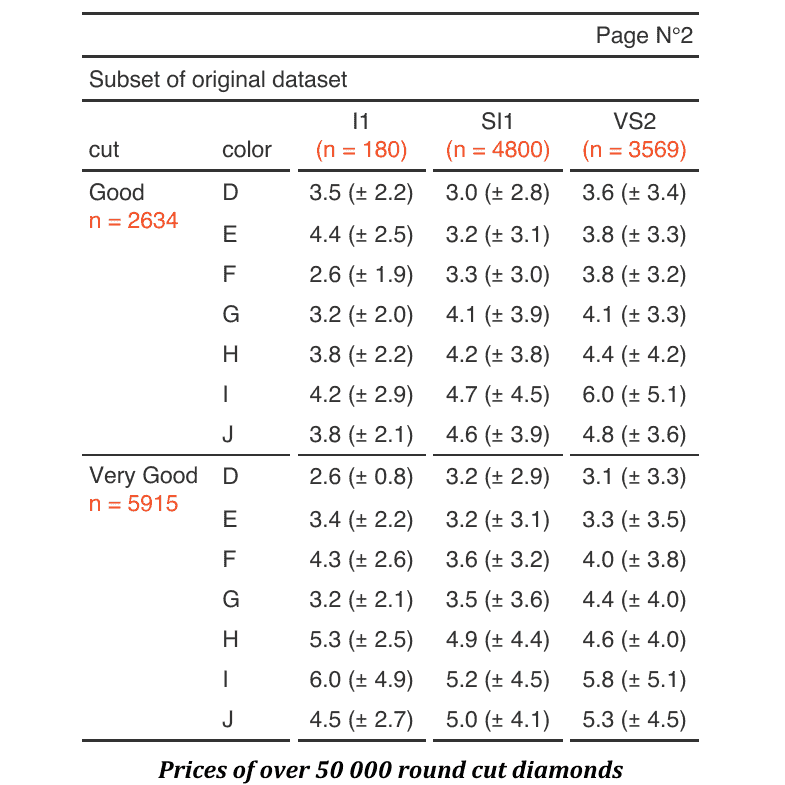| tabulator {flextable} | R Documentation |
Tabulation of aggregations
Description
It tabulates a data.frame representing an aggregation
which is then transformed as a flextable with
as_flextable. The function
allows to define any display with the syntax of flextable in
a table whose layout is showing dimensions of the aggregation
across rows and columns.

Usage
tabulator(
x,
rows,
columns,
datasup_first = NULL,
datasup_last = NULL,
hidden_data = NULL,
row_compose = list(),
...
)
## S3 method for class 'tabulator'
summary(object, ...)
Arguments
x |
an aggregated data.frame |
rows |
column names to use in rows dimensions |
columns |
column names to use in columns dimensions |
datasup_first |
additional data that will be merged with table and placed after the columns presenting the row dimensions. |
datasup_last |
additional data that will be merged with table and placed at the end of the table. |
|
additional data that will be merged with
table, the columns are not presented but can be used
with | |
row_compose |
a list of call to |
... |
named arguments calling function |
object |
an object returned by function
|
Value
an object of class tabulator.
Methods (by generic)
-
summary(tabulator): callsummary()to get a data.frame describing mappings between variables and their names in the flextable. This data.frame contains a column namedcol_keyswhere are stored the names that can be used for further selections.
Note
This is very first version of the function; be aware it can evolve or change.
See Also
as_flextable.tabulator(), summarizor(),
as_grouped_data(), tabulator_colnames()
Examples
## Not run:
set_flextable_defaults(digits = 2, border.color = "gray")
library(data.table)
# example 1 ----
if (require("stats")) {
dat <- aggregate(breaks ~ wool + tension,
data = warpbreaks, mean
)
cft_1 <- tabulator(
x = dat, rows = "wool",
columns = "tension",
`mean` = as_paragraph(as_chunk(breaks)),
`(N)` = as_paragraph(as_chunk(length(breaks), formatter = fmt_int))
)
ft_1 <- as_flextable(cft_1)
ft_1
}
# example 2 ----
if (require("ggplot2")) {
multi_fun <- function(x) {
list(mean = mean(x), sd = sd(x))
}
dat <- as.data.table(ggplot2::diamonds)
dat <- dat[cut %in% c("Fair", "Good", "Very Good")]
dat <- dat[, unlist(lapply(.SD, multi_fun),
recursive = FALSE
),
.SDcols = c("z", "y"),
by = c("cut", "color")
]
tab_2 <- tabulator(
x = dat, rows = "color",
columns = "cut",
`z stats` = as_paragraph(as_chunk(fmt_avg_dev(z.mean, z.sd, digit2 = 2))),
`y stats` = as_paragraph(as_chunk(fmt_avg_dev(y.mean, y.sd, digit2 = 2)))
)
ft_2 <- as_flextable(tab_2)
ft_2 <- autofit(x = ft_2, add_w = .05)
ft_2
}
# example 3 ----
# data.table version
dat <- melt(as.data.table(iris),
id.vars = "Species",
variable.name = "name", value.name = "value"
)
dat <- dat[,
list(
avg = mean(value, na.rm = TRUE),
sd = sd(value, na.rm = TRUE)
),
by = c("Species", "name")
]
# dplyr version
# library(dplyr)
# dat <- iris %>%
# pivot_longer(cols = -c(Species)) %>%
# group_by(Species, name) %>%
# summarise(avg = mean(value, na.rm = TRUE),
# sd = sd(value, na.rm = TRUE),
# .groups = "drop")
tab_3 <- tabulator(
x = dat, rows = c("Species"),
columns = "name",
`mean (sd)` = as_paragraph(
as_chunk(avg),
" (", as_chunk(sd), ")"
)
)
ft_3 <- as_flextable(tab_3)
ft_3
init_flextable_defaults()
## End(Not run)